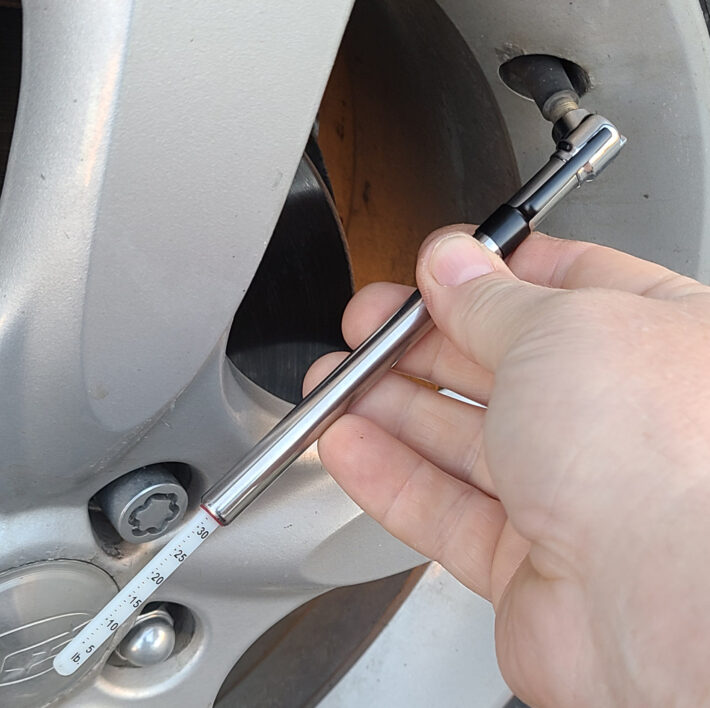*This article is geared towards a typical Soft-Roader rig with either very mild All Terrains or even street tires and traveling at slow speeds on rough roads. I have a previous article on tire pressure for Off-Road rigs HERE, which assumes you are on at least 30" All Terrain tires.
Lowering your tire pressure for dirt roads, or "Airing Down" is a widely debated topic. In one camp you have those who have never given it a fair try and those who have aired down then driven like a rally racer and pulled off a tire or damaged a wheel. In the other camp you have people like me who have been airing down for decades and have never had an issue because we have learned the right pressures for a given situation and we drive accordingly.
First and foremost airing down gives you more traction. As you let air out your tire flattens on the bottom and your contact patch increases. At low speeds the tire can also flex around small rocks that would otherwise cause it to skip and spin. This keeps you moving on rough roads and it also reduces damage to the roads caused by wheel spin.

Street Pressure

Low pressure
That ability to flex around rocks will also reduce the chance of cutting a tire on a sharp rock because the tire will flex around it, reducing the pressure on the rock.
Many people do not realize that your tire is also part of your suspension, so a tire that is softer due to less pressure will absorb bumps and give you a smoother ride. Those with older vehicles or stiffer suspensions will particularly benefit from this, but in any rig the reduced jarring is better for your vehicle and for your kidneys 🙂
The downsides of lowering your tire pressure are that you have a slight loss of clearance, aggressive cornering or excessive wheel spin can peel a tire off the wheel, your wheel is more exposed to damage from rocks, and you need to limit your speed or you can build up heat in your tire that can lead to tire failure. You also need to have a way to air up your tires before driving on pavement. Never drive more than a few minutes on pavement or above 60 kph with less than 80% of your regular street pressure.
That brings us to the tough question.....what pressure should you run? Unfortunately there is no easy answer as every vehicle and tire and wheel combination will be different, and even the same vehicle in different conditions will dictate different pressures.

To find my minimum tire pressure in my Subaru I loaded it with a typical day's gear and then positioned it in my sloped driveway at an angle with the front left tire up a oil-change ramp and a fist sized rock under the back right. This fully flexed my suspension and put a major portion of the vehicle weight onto the tire that is on the rock. Now I lowered my tire pressure until I had two inches of sidewall between the rock and the lip of the wheel. I feel that two inches is a safe "buffer" to protect the wheel. It is rare that I would have so much weight on one corner, but it simulates the extra impact force of hitting a rock while driving. For my Subaru this was 25 psi. For my Jeep, on the other hand, it is 8 psi. For some vehicles the street pressure may actually be as low as you can go.
Keep in mind that this is MINIMUM pressure to be used and is for low speed when maximum traction is needed. I would not be going around a corner at more than 30 kph at this pressure. I will sometimes drop to this for a tough climb and then go back up a bit for zipping down the smooth sections.
It is also important to note that this is based on having the ideal size wheel for your tire. For a vehicle that drives on dirt roads you want your wheel to be roughly an inch narrower than the contact patch of your tire tread. Not the sidewall, the tread. Typically a 31x10.5" tire is 10.5" wide at the widest part of the sidewall bulge and has a roughly 8" tread. For metric sizes convert the first number in the size (eg 255 in a 255/60R17) from mm to inches and subtract half an inch to get the tread contact patch width. When in doubt look up the recommended wheel widths for your tires and choose the narrowest width. The narrow wheel width pinches the bead for better retention and keeps the wheel further away from rocks. If your wheels are at the wide limit of what is recommended (or too narrow) then I would half the typical pressure drop, and if your wheels are wider than recommended then I would not drop pressure at all.
If you are worried about losing a tire off the wheel then an old 4x4 trick is that good tires shops will have a bead sealing compound they use for tires that are hard to keep sealed. It is often used on commercial trucks but rarely on street vehicles. The shop can use it to literally glue your tires to the wheels. If you do this then you will need to pay a couple extra bucks to have the inner bead of your wheel cleaned before mounting new tires.

